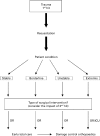Damage control resuscitation: lessons learned
- PMID: 26847110
- PMCID: PMC4886149
- DOI: 10.1007/s00068-015-0628-3
Damage control resuscitation: lessons learned
Abstract
Background: Damage control resuscitation describes an approach to the early care of very seriously injured patients. The aim is to keep the patient alive whilst avoiding interventions and situations that risk worsening their situation by driving the lethal triad of hypothermia, coagulopathy and acidosis or excessively stimulating the immune-inflammatory system. It is critical that the concepts and practicalities of this approach are understood by all those involved in the early management of trauma patients. This review aims to summarise this and discusses current knowledge on the subject.
Interventions: Damage control resuscitation forms part of an overall approach to patient care rather than a specific intervention and has evolved from damage control surgery. It is characterised by early blood product administration, haemorrhage arrest and restoration of blood volume aiming to rapidly restore physiologic stability. The infusion of large volumes of crystalloid is no longer appropriate, instead the aim is to replace lost blood and avoid dilution and coagulopathy. In specific situations, permissive hypotension may also be of benefit, particularly in patients with severe haemorrhage from an arterial source. As rapid arrest of haemorrhage is so important, team-based protocols that deliver patients rapidly but safely, via CT scan where appropriate, to operating theatres or interventional radiology suites form a critical part of this process.
Conclusions: Given that interventions are so time dependent in the severely injured, it is likely that by further improving trauma systems and protocols, improvements in outcome can still be made. Further research work in this area will allow us to target these approaches more accurately to those patients who can benefit most.
Keywords: Damage control surgery; Polytrauma; Resuscitation; Severe haemorrhage.
Figures



References
-
- Roberts CS, Pape HC, Jones AL, et al. Damage control orthopaedics: evolving concepts in the treatment of patients who have sustained orthopaedic trauma. Instr Course Lect. 2005;54:447–462. - PubMed
Publication types
MeSH terms
Substances
LinkOut - more resources
Full Text Sources
Other Literature Sources
Medical
Research Materials

